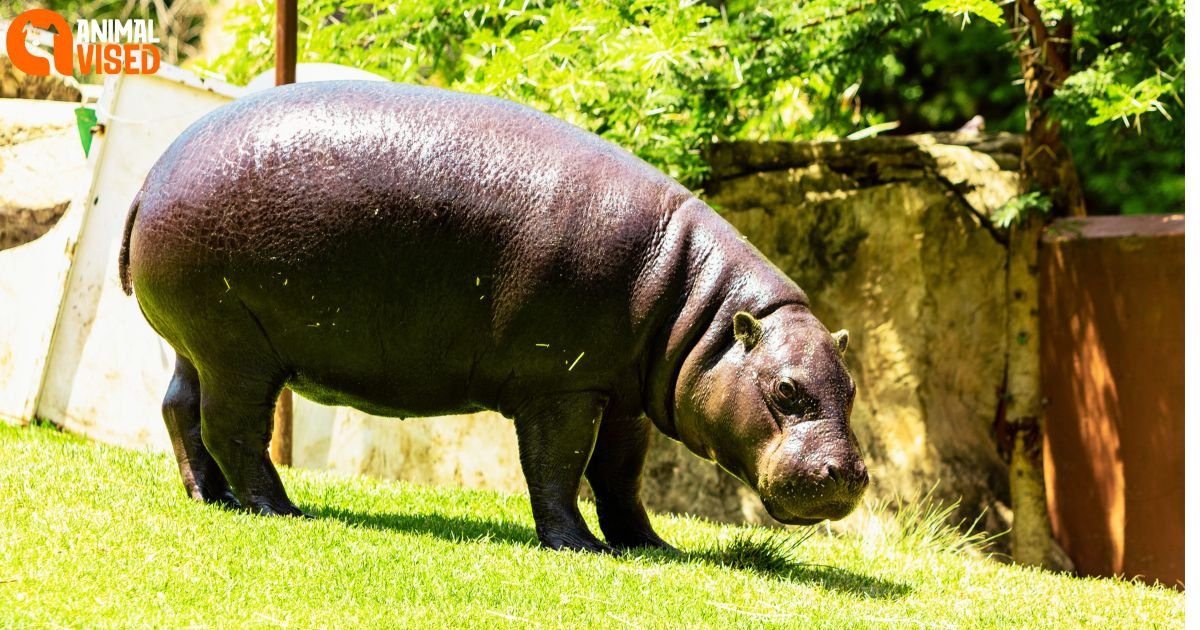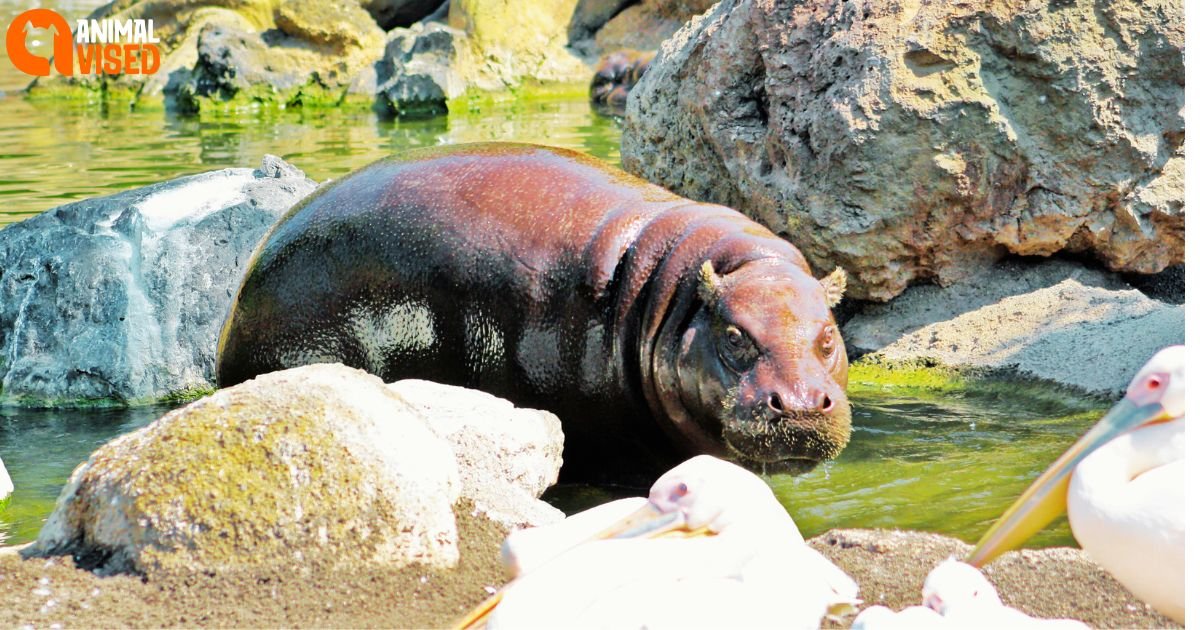Introduction:
The pygmy hippopotamus, a shy and elusive creature, thrives in the dense rainforests of West Africa. Often shrouded in mystery, this miniature hippo relative holds a special place in the animal kingdom. This article delves into the fascinating world of the pygmy hippo, exploring its habitat, diet, behavior, and the threats it faces.
In the vast tapestry of the animal kingdom, few creatures capture the imagination quite like the pygmy hippopotamus. This diminutive cousin of the larger and more familiar Nile hippopotamus is a true marvel of nature, a testament to the incredible diversity that exists within even the most well-known animal families.
Read More: Animal Extinction

Baby Pygmy Hippopotamus
Pygmy Hippopotamus, scientifically known as Choeropsis liberiensis, is a unique and endangered species of hippopotamus found in the dense rainforests of West Africa. Despite their name, these animals are not truly miniature versions of their larger cousins, the common hippopotamus. They are a distinct species that has evolved to thrive in the lush, tropical environments of their native habitats.
The birth of a Hippopotamus is a rare and remarkable event. These tiny creatures enter the world weighing around 6-14 pounds (2.7-6.4 kg), a far cry from the massive newborns of the common hippopotamus, which can weigh up to 100 pounds (45 kg). The gestation period for a Pygmy Hippopotamus is around seven months, and the mother typically gives birth to a single calf.
The newborn Hippopotamus is born with a thick coat of reddish-brown hair, which serves as excellent camouflage in the dense undergrowth of the rainforest. This hair gradually falls out as the calf grows, revealing the smooth, semi-aquatic skin that is characteristic of adult Pygmy Hippopotamuses.
Pygmy Hippopotamus Predators
Despite their small size, Pygmy Hippopotamuses have few natural predators in their rainforest habitat. Adult individuals are formidable and can defend themselves with their sharp tusks and powerful jaws. However, newborn calves and juveniles are more vulnerable to predation.
One of the primary predators of Pygmy Hippopotamuses is the leopard. These stealthy and powerful cats are adept at hunting in dense forests. They can pose a threat to young or isolated individuals. Other potential predators include pythons, which can constrict and suffocate smaller Pygmy Hippopotamuses, and crocodiles, which may opportunistically prey on individuals that venture too close to waterways.
Unfortunately, human activity poses the greatest threat to the survival of Pygmy Hippopotamuses. Habitat loss due to deforestation, poaching for bushmeat and ivory, and the illegal pet trade have all contributed to this species’ decline in recent decades.
Pygmy Hippopotamus Habitat
The Hippopotamus is a valid resident of the West African rainforests, inhabiting regions spanning from Liberia to the Ivory Coast. These dense, humid forests provide the ideal environment for these semi-aquatic creatures, offering ample vegetation, water sources, and shelter.
Unlike their larger counterparts, the common hippopotamus, which prefers open waterways and grasslands, the Pygmy Hippopotamus thrives in the thick undergrowth and swampy areas of the rainforest. They are highly adapted to this environment, with their compact size allowing them to navigate through the dense foliage with ease.
Pygmy Hippopotamuses are solitary and territorial animals, marking their territories with scent glands and vocalizations. They are primarily nocturnal, spending the daylight hours resting in dense thickets or wallowing in mud or water to regulate their body temperature and protect their sensitive skin from the sun.
Pygmy Hippopotamus Diet
The Pygmy Hippopotamus is an herbivore that subsists on a varied diet of plant matter found in the rainforest. Its broad mouths and powerful jaws are well-suited for grazing on grasses, leaves, fruits, and aquatic vegetation.
One of their favorite foods is the wild semi-aquatic plant known as Cymodocea, which grows abundantly in the swampy areas they frequent. They also consume a variety of fruits, such as bananas and mangoes, when they are in season.
Hippopotamuses are excellent swimmers and can hold their breath for several minutes, allowing them to forage for aquatic plants and roots in the rivers and streams that crisscross their habitat.
Pygmy Hippopotamus Live
Pygmy Hippopotamuses are solitary animals, living and foraging alone for the majority of their lives. They are highly territorial, marking their home ranges with scent glands and vocalizations to deter other individuals from encroaching.
These elusive creatures are primarily nocturnals. At night, they emerge from their dense hiding places to feed and swim in the rainforest’s rivers and streams. During the day, they rest in secluded areas, often wallowing in mud or water to keep calm and protect their sensitive skin from the sun.

Despite their solitary nature, Pygmy Hippopotamuses are known to congregate occasionally, particularly during the breeding season. Males will compete for access to females, engaging in displays of aggression and vocalizations to assert their dominance.
Pygmy Hippopotamus Size
The Hippopotamus is a diminutive member of the hippopotamus family, standing between 2.5 and 3 feet (0.75 and 0.9 meters) tall at the shoulder and weighing between 350 and 600 pounds (159 and 272 kg). This makes them substantially smaller than their larger cousins, the common hippopotamus, which can weigh up to 3 tons (2.7 metric tons).
Despite their compact size, Pygmy Hippopotamuses are well-equipped for life in the rainforest. Their short, stocky legs and thick, barrel-shaped bodies allow them to navigate through the dense undergrowth with ease. Their broad mouths and powerful jaws are well-suited for grazing on the abundant vegetation in their habitat.
One of the most striking features of the Hippopotamus is its proportionately larger head in relation to its body size. This feature, coupled with their small, round ears and large eyes, gives them an endearing and almost comical appearance.
Pygmy Hippopotamus Endangered
The Pygmy Hippopotamus is classified as an endangered species by the International Union for Conservation of Nature (IUCN). Their population has declined dramatically over the past few decades due to a combination of threats, including habitat loss, poaching, and the illegal pet trade.
Deforestation in West Africa has had a significant impact on the Pygmy Hippopotamus’ habitat, reducing the available space and resources for these animals to thrive. Additionally, they are hunted for their meat and ivory tusks, which are valued in some regions for traditional practices or as trophies.
The illegal pet trade has also contributed to the decline of the Hippopotamus population. Their small size and endearing appearance make them appealing as exotic pets, leading to the capture and smuggling of these animals from their natural habitats.
Conservation efforts are underway to protect the remaining wild populations of Pygmy Hippopotamuses. These include habitat preservation, anti-poaching measures, and captive breeding programs aimed at bolstering their numbers and ensuring their survival for future generations.
Pygmy Hippopotamus Baby
The birth of a Hippopotamus baby is a rare and precious event, as these animals have a relatively low reproductive rate compared to their larger counterparts. Gestation lasts around 7 months, and the mother typically gives birth to a single calf weighing between 6 and 14 pounds (2.7 and 6.4 kg).
Newborn Pygmy Hippopotamus calves are covered in a thick coat of reddish-brown hair, which serves as excellent camouflage in the dense undergrowth of the rainforest. This protective coat gradually falls out as the calf grows, revealing the smooth, semi-aquatic skin characteristic of adult individuals.
The bond between a Pygmy Hippopotamus mother and her calf is powerful, and the mother is fiercely protective of her offspring. The calf nurses for several months, gradually transitioning to a diet of vegetation as it matures.
Despite their small size, Pygmy calves are intelligent and can swim and walk shortly after birth. However, they remain dependent on their mothers for several years, learning vital survival skills and navigating the complex rainforest environment.
Baby Pygmy Hippopotamus
A pygmy hippo calf is a sight to behold! Weighing around 10 pounds at birth, these adorable creatures are born after a gestation period of 6-7 months. Unlike their larger relatives, pygmy hippo mothers typically raise their young alone, providing them with milk for up to eight months. Calves are intelligent and can walk within a few hours of birth, but they stay close to their mothers for protection and to learn foraging skills.
Pygmy Hippopotamus Predators
Despite their stocky build, pygmy hippos are vulnerable to a few predators in their forest habitat. Leopards and large crocodiles pose a threat to young calves. At the same time, adult hippos can fall prey to spotted hyenas working together. However, their elusive nature and nocturnal habits help them avoid encounters with predators.
Pygmy Hippopotamus Habitat
Unlike its aquatic cousin, the common hippopotamus, the pygmy hippo prefers the calm, damp environment of West African rainforests. They spend their days hidden in dense vegetation near rivers, streams, and swamps. These freshwater sources are crucial for thermoregulation. Pygmy hippos can’t sweat effectively and rely on mud baths and water to stay calm.
Pygmy Hippopotamus Diet
While pygmy hippos share the herbivorous diet of their larger relatives, their smaller size and forest habitat dictate their food choices. They are primarily browsers, feeding on leaves, fruits, and fungi found on the forest floor. Their powerful jaws and sharp incisors help them tear through thorny vegetation. Pygmy hippos may also occasionally graze on grasses near rivers.
Pygmy Hippopotamus Life
Pygmy hippos are solitary creatures, with males leading territorial lives and females having smaller home ranges. They communicate through vocalizations, including grunts, snorts, and bellows, to defend their territories and attract mates. Pygmy hippos can live up to 35 years in the wild, with some individuals exceeding 50 years in captivity.
Pygmy Hippopotamus Size
The most striking difference between the common hippo and the pygmy hippo is their size. While the common hippopotamus can weigh up to 8,000 pounds, the pygmy hippo is an actual miniature, reaching only 4-5 feet in length and weighing between 280 and 600 pounds. Despite their smaller size, pygmy hippos have powerful jaws and sharp incisors, adaptations for their plant-based diet.
Pygmy Hippopotamus Endangered
The pygmy hippopotamus is classified as endangered by the IUCN. Habitat loss due to deforestation and illegal logging is a major threat. Additionally, hunting for meat and bushmeat poses a significant danger. Conservation efforts are underway to protect the remaining populations and their forest habitats.
Pygmy Hippopotamus Baby (for Kids)
Imagine a tiny hippo about the size of a big dog! That’s a pygmy hippo baby! These cuties are born in the rainforest and learn everything from their mom, like how to find yummy leaves and fruits to eat. They can even walk just a few hours after birth!
Pygmy Hippopotamus Facts for Kids
- Pygmy hippos are shy and only come out at night.
- They sweat a pink liquid to stay cool!
- Pygmy hippos are great swimmers, but they prefer to stay on land.
- Their closest relatives are actually whales and dolphins!
Pygmy Hippopotamus Facts
- Pygmy hippos are the only living members of the genus Choeropsis.
- Their scientific name, Choeropsis liberiensis, translates to “hog-like creature from Liberia.”
- Pygmy hippos have a symbiotic relationship with certain bacteria in their stomachs that helps them digest their strict diet.
- They are considered keystone species, meaning their presence is vital for the health of the rainforest ecosystem.

Read More: Pygmy Hippopotamus
Conclusion:
The Pygmy Hippopotamus is a captivating and unique species that has captured the hearts of many with its endearing appearance and fascinating adaptations to life in the West African rainforests. Despite their small stature, these animals are remarkably resilient and possess an array of traits that have allowed them to thrive in their specialized habitats.
However, the future of the pygmy hippopotamus is in delicate balance. Threats such as deforestation, poaching, and the illegal pet trade have significantly impacted their populations, pushing them to the brink of extinction. Conservation efforts, including habitat preservation, anti-poaching measures, and captive breeding programs, are crucial to ensuring the survival of this remarkable species for generations to come.
FAQs:
Q: Can pygmy hippos live with common hippos?
A: No, pygmy hippos and common hippos are not typically found living together. Pygmy hippos prefer the solitude of the rainforest. In contrast, common hippos are social creatures that thrive in large herds near water sources. Their size difference and habitat preferences make cohabitation unlikely.
Q: Are pygmy hippos dangerous?
A: Pygmy hippos are generally shy and avoid contact with humans. However, they can become aggressive if they feel threatened, especially when protecting their young. It’s essential to maintain a safe distance from these wild animals.
Q: Where can I see pygmy hippos?
A limited number of zoos worldwide house pygmy hippos. Visiting a zoo that participates in pygmy hippo conservation programs can be a great way to learn more about these fascinating creatures and support their survival.
Q: What can I do to help pygmy hippos?
A: There are several ways you can help pygmy hippos. You can support organizations working on pygmy hippo conservation. Reducing your paper consumption and choosing sustainably sourced wood products can help combat deforestation, which threatens the pygmy hippo habitat. Spreading awareness about the importance of pygmy hippo conservation can also make a difference.
By understanding the unique characteristics and challenges faced by the pygmy hippopotamus, we can appreciate its role in the rainforest ecosystem and contribute to its continued survival for generations to come.
Q: Are Pygmy Hippopotamuses related to the common hippopotamus?
A: While they belong to the same family (Hippopotamidae), Pygmy Hippopotamuses are a distinct species from their larger cousins, the common hippopotamus. They have evolved separately to adapt to life in the dense rainforests of West Africa.
Q: How big do Pygmy Hippopotamuses get?
A: Adult Pygmy Hippopotamuses are 2.5–3 feet (0.75–0.9 meters) tall at the shoulder and weigh 350–600 pounds (159–272 kg), making them significantly smaller than the common hippopotamus.
Q: What do pygmy hippopotamuses eat?
A: Pygmy Hippopotamuses are herbivores and feed on a variety of plant matter, including grasses, leaves, fruits, and aquatic vegetation found in their rainforest habitat.
Q: Are Pygmy Hippopotamuses endangered?
A: Yes, the Pygmy Hippopotamus is classified as endangered by the International Union for Conservation of Nature (IUCN) due to threats such as habitat loss, poaching, and the illegal pet trade.
Q: How long do Pygmy Hippopotamuses live? A: In the wild, Pygmy Hippopotamuses can live up to 42 years, while in captivity, their lifespan can reach around 55 years.
Q: Where are Pygmy Hippopotamuses found?
A: Pygmy Hippopotamuses are native to the dense rainforests of West Africa, primarily in countries like Liberia, Sierra Leone, Guinea, and the Ivory Coast.
Q: Are Pygmy Hippopotamuses social animals?
A: No. Pygmy Hippopotamuses are generally solitary and territorial animals. They mark their home ranges with scent glands and vocalizations to deter other individuals from encroaching.
Q: How many babies do Pygmy Hippopotamuses have at a time?
A: Pygmy Hippopotamuses typically give birth to a single calf after a gestation period of around seven months. The newborn calves weigh between 6-14 pounds (2.7-6.4 kg) at birth.










